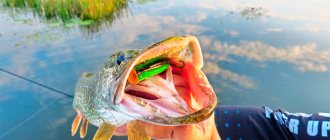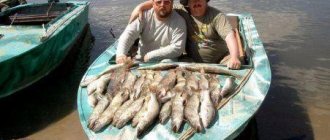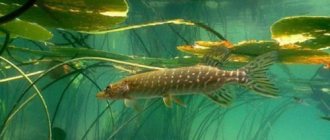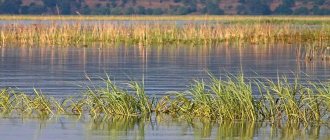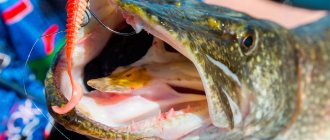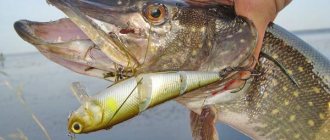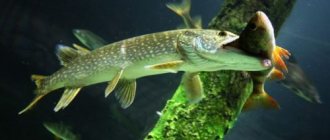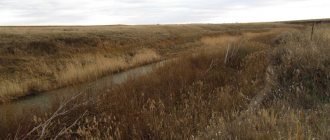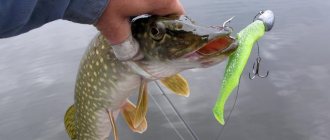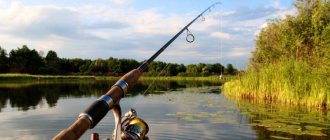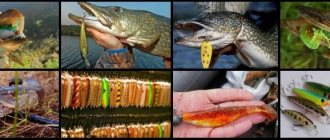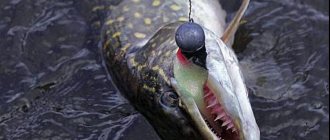Equipment
Before going fishing, you need to carefully select and prepare your gear . Having studied their characteristics, you can collect equipment that will not let you down at the right time.
The length of the rod for jig bait depends on the fishing method:
- from the shore – 2.2 – 2.7 meters;
- from a boat – 1.7 – 2.1 meters.
If conditions are constantly changing, you should choose a universal size - from 2.1 to 2.4 meters . This value has proven itself well and is suitable even for novice fishermen. The main thing is that the other characteristics of the spinning rod match.
of a fishing rod is its response to load levels. Opinions differ about the optimal action for a jig spinning rod. It should be loud and sensitive. In fast current conditions, a Fast action with a cast of 15-40 g is appropriate. In difficult waters and when using heavy and large baits, choose a rod with an L-fast action and a cast of 20-56 g.
The manufacturer is not always important when choosing a spinning rod for jigging. Some companies offer a whole line of high-quality spinning rods; you can find what you need at a reasonable price.
The main requirement for a reel is the presence of a metal spool . This requirement is due to the use of braided cord. The clutch is front, although the rear is used with the same success. For a medium jig, a reel with a line capacity of up to 3000 Shimano is suitable.
The fishing line is suitable braided , with a diameter of at least 0.18 mm.
We recommend using fluorocarbon leashes with a length of 1 meter or more. Line diameter – 0.25-0.3 mm. It is invisible under water and stretches well. The windage of the material slows down its progress under water, and the slower the bait, the more it attracts a predator.
A leash twisted from string is considered reliable . Its diameter will be 0.17 mm, length 5 cm. It is mounted to a fluorocarbon piece. A jig is attached to the untwisted leash and twisted again.
Jig fishing tackle
For jig fishing you should use the following gear:
Coil. It is recommended to use a spinning reel, since it is considered the most convenient when fishing with a jig. It is also desirable that the reel also have a friction brake (front and rear).
Fishing line. Only braided fishing line should be used, since it does not have the ability to stretch, unlike monofilament, which is a very important criterion for this fishing method. The diameter of the fishing line should be selected according to the load it will withstand. To catch small fish up to three kilograms, you should use a fishing line with a diameter of 0.13 mm, and for catching larger fish, a fishing line with a number of 0.26 mm is suitable.
Choosing the right jig head for pike
When choosing a jig head, you should rely on several recommendations:
- The weight of the sinker varies depending on the direction of the current . When moving against the current, the head is required to be heavier; when moving with the current, it is lighter.
- The bait should sink to the bottom slowly , with pauses of ten seconds.
- Select a jig head that matches the test performance of the rod . This will ensure that even the most careful bite is visible.
For pike fishing, the lightest possible heads in the weight range from 5 to 15 grams are suitable. This is a universal take-off run, which is designed for both shallow water areas and diving into 10-15 meter holes.
Light weight gives the effect of soft play and slowly sinking baits attract the attention of even passive pike.
How and where to catch pike on a jig
Catching pike with a jig is possible both in standing reservoirs (lakes, quarries) and in currents (rivers and reservoirs). On small and shallow rivers, it is more often practiced to catch catfish with a micro jig, although in this case both small and large fish will be caught on the hook.
On rivers, the most promising are bends and turns where holes form. In the pits, the entrances and exits are fished first. Ideally, there are flooded snags and trees at the bottom. No less interesting are river pockets, where the reverse current makes a hole. Also on the river, pike can be found in places where there are significant differences in the bottom topography, whirlpools, channel dumps, ditches, and places covered with snags. Near thickets of water lilies or at the edge of reeds.
To look for pike on lakes and flooded quarries, you need to be near steep bank edges, in places where a stream or rivulet flows into a reservoir, the main thing is that there is the depth necessary for our gear. At the entrances and exits of pits, hills, depressions, as well as among bottom anomalies, which the fanged one can use as an ambush.
In reservoirs, pike are caught with a jig at depth, especially if there are flooded trees, snags and stumps (for example, there was a grove or planting before the flooding). Along the coastline overgrown with reeds. The areas around the islands have uneven bottom topography and pike will always find a place to ambush. No less interesting are the various shallows, just not the coastal ones, but such as the bay, or the shallows at a distance from the coast, surrounded by depths.
Spring
You can go after the fanged fish as soon as the rivers are free of ice. Moreover, even if the reservoir is not yet completely free of ice, and there are only individual open areas, then you can fish them by throwing the equipment as close to the edge of the ice as possible or by fishing along it.
In early spring, pike fishing with jigs is primarily successful:
- In areas where a river or stream flows into a reservoir, as well as near oxbow lakes and backwaters.
- Entrances and exits from pits and ditches;
- Medium depths with significant uneven terrain;
- Snags;
In early spring, the fish have not yet fully recovered from wintering, and the water is quite cloudy, so to catch pike with a jig, light-colored baits with passive play and slow retrieval are used. Now, the best time for fishing will be after lunch and before sunset; you can also fish in the morning, starting at 8-9 o’clock. But fishing after sunset and early at dawn, in early spring, is not recommended.
The burst of activity of spring pike is very short-lived and is limited to the beginning of spawning, which falls in March or April, depending on the region (water temperature 6-7 0C). During this period, a ban on fishing begins to apply, and the fish goes to shallow waters overgrown with vegetation (river branches, bays, oxbow lakes, flood lakes) and practically does not react to the bait. After spawning, the fish remain here for some time, actively eating, and then go to their summer camps.
Summer pike fishing with jig
In summer, pike comes closer to shallow water areas located at the edge of aquatic vegetation, here it actively hunts for small fish. In such places, it is much more effective to catch pike not with a heavy jig, but with wobblers (minnows) or poppers. A solution could be to use a micro jig, but in this case a lot of small things will fall on the hook. The bait is carried along the coastal vegetation, or submerged bushes and snags are fished pointwise.
Using a standard jig, pike can be caught in the following areas:
- Snags at medium depths;
- Near bridge supports and other hydraulic structures;
- On coastal dumps and edges;
- River beds, rifts and edges of holes;
- In areas where tributaries flow into the main channel of the river;
- In places where a spring comes out of the ground;
- In pools located under the shadow of tree crowns hanging over the water;
- The best time for biting is morning and evening.
Autumn
Catching pike in the fall with a jig will be the most effective, both in terms of the size of the trophy and their quantity. At the same time, jig fishing for catfish is possible until water bodies are covered with ice. At the beginning of autumn, while the days are warm, the fish are still in no hurry to leave their summer camps, but when the water temperature drops to 15-13 0C, the pike begins to have an autumn meal and actively moves around the reservoir in search of prey.
With each subsequent cold snap, the pike moves further and further from the shore to greater depths. In autumn you need to look for pike:
- On the edges;
- Svalakh to depth;
- Deep holes;
- Dense snags;
- Water tables, 4-8 meters deep;
Nowadays jig fishing from a boat is very effective, when we can fish distant holes and edges that are inaccessible to fishing enthusiasts from the shore. At the same time, we can present the bait at different angles, which also increases our chances of getting a fanged one into our treasury. In autumn, aggressive jigging and the use of large silicone baits are recommended.
In autumn, pike can be caught well on jigs throughout the daylight hours.
What's the best way to fish?
For jig fishing for pike, large, long and voluminous . The material for their manufacture can be different, and the colors depend on the color of the bottom, its texture, the transparency of the water in the reservoir, lighting, and the type of food fish for a given area.
Silicone baits
The leaders in the list of jig baits are soft baits made of silicone. Even an experienced fisherman can get confused in the assortment of twisters, vibrotails, worms, crayfish, edible and inedible . The price for them fluctuates, so you can always choose a bait that suits your pocket.
Jig baits are divided into active and passive. For pike fishing, baits of the first type, with their own game, are more often used. They imitate food objects that the predator attacks.
Pike take silicone baits well - they are soft, easily fit into the mouth and perfectly hide the hook, due to their volume . They are equipped with noise capsules to attract predatory fish with sound. All additions in the form of petals, turbines, propellers are made specifically to increase the irritating effect.
It is worth remembering that improving the bait makes sense only when catching trophy pikeif the fisherman is absolutely sure that it is in a given area of the reservoir. Otherwise, there is a huge risk of losing an attachment of decent value.
Foam rubber baits
The most accessible and cheapest baits are fish made from foam rubber and polyurethane foam. They are ideal for cluttered areas of the reservoir, in remote places of snags, in the coastal part of rivers and lakes.
The catchability of the bait is explained by the fact that it is not spared and the fishermen perform the retrieve slowly, sometimes even leaving the artificial fish at the bottom among the snags.
The body of the foam rubber bait covers the hook. It is dipped in blood or oil to attract the spotted predator with the smell.
Spinners
For catching pike with jigs, only those variants of rotating spoons that are assembled on a wire frame . It can be bare, covered with a cambric or rubber tube.
The loading is front, which allows the bait to sink to the bottom with the jig head, and the petals do not stop rotating. An important point: the petals must be deflected at least 45 degrees .
For all types of jig baits, it is appropriate to use attractants , which enhances the bite.
Read here how to properly place baits on jig heads and tie them to a fishing line.
Eared sinker in a jig
When choosing a universal bait, you should focus only on certain characteristics that carry certain advantages. And this is very important, because today there is a lot of advertising and frankly useless spinning ideas are presented almost as a loud sensation.
Is it worth looking for eared sinkers with expressive eyes and silicone baits with scales and fins on sale?
Since jig fishing involves fishing holes and the main channel, I opted for “slender” baits. Almost all the vibrating tails I use are 10 cm long and 1.5 cm wide and work equally well both in currents and in still water. In addition, the sensitivity of the gear when using a compact bait increases. And it’s easier to make it move along the intended fishing path than a bulky, wide-bodied, sailing rubber that is constantly carried away by the current from the fish’s parking area.
Why do I use vibrating tails in most cases?
It’s just my preference, but I’m not at all saying that the twister will perform worse in practice. Again, when choosing bait, everything will depend on the fishing conditions. Half a dozen trips are enough for me to get a good feel for the seasonal situation and act with confidence. But you can mindlessly catch fish on a pond for five years and know nothing about it.
[THERE IS AN ANSWER] How to put live bait on a pike hook
Imagine this picture
When choosing a fishing spot, any spinning angler always faces the choice of bait. Which one to put: with an open hook, or still go with a non-hooking one. After all, if a place is heavily charged, then you can lose a considerable part of your arsenal.
How to choose bait?
But is it worth using non-snagging baits in all unfamiliar places? After all, there are areas in which even with a visual inspection, or rather, guided by the coastline, you can predict whether the bottom will be snagged or not. For example, if both banks are clean, there are no trees or bushes, then, as a rule, there are no snags under water, unless they were brought in by a strong current. Of course, if in doubt, you can first check all areas of the hole with a non-snacking tool.
By the way, when scouting, it is better to use a heavier load than the fishing conditions require. The increased weight of the eared sinker helps to more thoroughly monitor various anomalies and features of the bottom, and this way we will quickly understand the overall picture of the channel. Accordingly, in the future it will be easier to navigate when choosing bait and searching for fish sites.
When fishing for predatory fish in thickets of aquatic vegetation, snags, or near fallen trees, unhooked baits come to the aid of the angler. Some head shapes (spoon, rugby, horseshoe, boot) are less likely to be hooked due to the vertical position of the hook in the fall and the staggered retrieve. Other jig heads have an elongated shape (banana, ski), thereby reducing the likelihood of a side hook.
Pike fishing technique
The most used tactic for catching a spotted predator with a jig is the classically executed “step” .
The bait is lowered to the bottom of a lake or river, then, placing the rod at an acute angle, make up to 4 rotations with the reel handle. The position was not chosen by chance - it guarantees effective hooking when quickly straightening the spinning rod to a right angle. Lower the nozzle to the bottom again and repeat reeling.
With the help of a spinning rod, the bait is also detonated - after casting, the tip of the rod is brought to the splashdown point of the artificial food.
Mark the slack in the cord and set the spinning rod perpendicular to the water . Wait for the bait to fall to the bottom, constantly changing the position of the rod from 45 to 60 degrees and back. Repeat all the steps again.
Bites are detected by the movement of the tip of the spinning rod and by changes in the tension of the fishing line. Most of them occur at the moment of pause, while the pike attacks the prey from below. As soon as you feel a poke and blow, you should immediately make a hook. As soon as it becomes clear that the predator is on the hook, another 2-3 hooks are made.
To quickly fish the territory of a reservoir and detect accumulations of fish, search fishing techniques .
A weighted jig head can be cast in any direction and carried with a classic step in an accelerated version. Bites signal the location of predators.
Having decided on an area that is promising for fishing due to frequent bites, you can move on to local fishing . The heavy jig head is replaced with a lightweight version that provides a soft feed of the bait.
Now the fishing speed is reduced, and the artificial bait reaches the bottom in 5-7 seconds.
Spot fishing for pike with a jig is the most effective.
When catching pike with twisters, the wiring technique changes slightly. The braid is reeled in evenly , and the movement of the tip of the spinning rod forces the bait to play.
We believe that the best retrieving technique remains one where the animation of the bait is ensured by the rotation of the reel, while the rod remains motionless .
Edible rubber
Edible rubber has become very popular lately. It became the No. 1 bait for me and my spinning friends. And this despite the high cost. Against the background of edible rubber, other silicone baits remain behind the scenes. But you shouldn't lose sight of them. There are often times when the same perch actively feeds and stays in large schools. In this case, silicone, which is stronger than “edible”, will come to the rescue. But I will tell you, based on my own experience, when the fish is inactive, it is much more difficult to “stir up” it without using a miracle “edible”. The point, in my opinion, is not even in the “edible” silicone itself, but in its softness, smell and correctly selected size. The attractant and salt are part of the silicone itself. It also means a lot that edible rubber is mainly made for inactive models (“worms”, slugs, “crustaceans”, octopuses, etc.), but they can provoke even the most inactive fish to bite. And not only predatory. You can purposefully catch peaceful fish with “edible bait”: crucian carp, rudd, etc. But surprises also happen when catching a predator. On one of the last pike fishing trips, carp pecked at edible rubber. There were a lot of bites, and there were gatherings. But we still managed to catch two carp. In the photo there are carps of 4.2 kg and 2.8 kg.
Today, when the market is flooded with a wide range of edible rubber, it is difficult not to get confused and buy something worthwhile. Unfortunately, not everyone fishes well. What are the criteria for determining high-quality and catchable edible silicone? First of all, these are reviews from friends who have tried this or that edible bait. But if there are no such people among your friends, then I will give some advice. They can be very useful for beginners learning how to catch pike with a jig.
So, the first and most important thing when choosing edible rubber is the presence of an attractant and salt in the silicone itself. Many manufacturers impregnate ready-made silicone bait with various attractants and sprinkle with salt. I call such baits conventionally “edible”, since both the salt and the attractant are quickly washed off and the silicone must then be lubricated with the attractant. In real edible rubber, the attractant and salt are initially added to the silicone composition. Therefore, they never lose their smell and taste.
The second, no less important, criterion is the presence of sparkles in the bait. This component significantly increases the number of pike bites.
Well, the third criterion is the similarity in size, shape and color of the intended target of pike hunting. These are all kinds of imitations of fry, crustaceans, worms, etc.
Pike loves smooth, leisurely movements with a sweeping play of the bait, which hovers above the bottom, slowly moving its tail and creating micro-oscillations. Such vibrations simply have a magical effect on the hunting instinct of the pike and provoke it to attack. All this is true if you take a twister or vibrotail. Basically, edible rubber, which is really catchy (especially “worms”, “crustaceans”, slugs, etc.), does not have its own game. Therefore, animation of these baits is necessary, created using spinning rods and different types of wiring. For this you need a corresponding spinning kit, but more on that later.
Size and color of jig baits
Let's take a closer look at jig baits for pike. Speaking about them, I will be based on personal experience that I was lucky enough to acquire at competitions and consolidate in practice of private fishing, as well as when observing athletes who purposefully catch pike with a jig. In principle, for pike the main component is the wiring itself. Therefore, a silicone bait should be chosen so that it is as resistant as possible to breaks on aquatic vegetation, stones, and shells. In terms of size, I prefer lures 2-2.5 inches long if the pike are inactive, and larger lures (no more than 10 cm) for active pike in late fall.
This year I was faced with a situation that was completely incomprehensible to me. And if I hadn’t tried it myself, I would never have believed it. It turns out that even in murky water, pike and other predators like dark colors and transparent silicone. Moreover, inclusions of glitter in silicone of any color dramatically increase the catchability of the bait. Of course, poisonous colors (light green, burning crimson, etc.) also attract pike, but dark colors (brown, caramel, machine oil, dark purple and even black) attract pike much better precisely during the period of its passivity. And if it’s also edible rubber... So, we’re on a pond. What to apply in specific conditions at this time of year? By specific conditions, I mean a body of water with or without current, its depth, the presence of vegetation on the bottom and surface, and much more. But you don’t need to take my advice as some kind of law. In order to properly mount the tackle, you need to understand the entire upcoming fishing process and, based on this, think about choosing a bait, its loading and wiring. So, let's take the minimum weight of the jig head as a basis. Well, let's say 2-3 grams. In this case, our bait is a “worm”, a slug, a “crustacean” or something similar, 2–2.5 inches (5–6.3 cm) long. With this set, you can comfortably fish at depths from 1 to 3–4 m, depending on the wind strength. It is also worth adding that with a smaller jig head, there will be more bites.
Fishing from a boat
Catching predatory fish with a jig in shallow water does not bring good results . Fishing is much more effective at depths with fast currents and complex bottom topography, where pike like to camp.
First of all, you need to approach the spot where the spotted predator is supposed to stay by boat.
A promising point is explored with an echo sounder and fished with a heavy jig bait . An artificial bait for direct fishing is cast in the direction of the current and pulled against it.
Classic wiring is used, and when casting “into the banks” the gaps increase somewhat, which allows the pike to attack the bait.
When fishing from a boat, fishermen note the effectiveness of Surplyas fishing . The rod is cast downstream. When the bait has reached the bottom, pull it back up by tightening the spinning rod (without winding the cord). Afterwards everything returns to its original position.
How to avoid wasting silicone baits
And finally, I want to talk about how to avoid losing silicone baits when jigging. I think many people encounter this problem quite often.
At the same time, you can catch that pike that coveted the silicone bait, but for various reasons only grabbed the tail. In such cases, the fisherman makes a hook and breaks off the tail of the bait.
To prevent this from happening, there is the installation of a miniature (commensurate with the size of the bait) three-piece in the tail of our bait. Most often, this installation is used in “worms” and slugs, the shape of which allows this to be done. It would be a mistake to connect the tee hook to the main hook (usually a single hook) directly. This type of connection will “steal” the elasticity of the bait. It would be better to mount the tee in the tail of the bait using a piece of cord, which we will stretch along the axis of the body using a sewing needle or for attaching boilies to the hair when fishing for carp. The cord is tied to the main hook - and the tackle is ready. It remains elastic, but a pike that decides to bite off the tail of the bait with impunity will be in for an unpleasant surprise.
In closing, I would like to quote Winston Churchill, who said: “Watching is one thing. Seeing what you're looking at is different. Understanding what you see is something else. Learning from what you understand is something completely different. But acting on what you learn is what really matters!”
Look, observe, become aware of what you see, and learn. Then you will definitely catch the fish you dream of.
Jig for pike from the shoreline
When fishing for pike from the shore, the rod is taken longer than when fishing from a boat. Places where you can reach the river bed from the edge are well fished and are often visited by spinning anglers. It is better to choose impassable, inconvenient places where the fish in the coastal zone are not scared away.
In such places there is little room to turn and a rod length of 2 meters 70 centimeters will be optimal.
fish from the shore using dotted lines .
Having cast the line, the rod is held horizontally in relation to it. When the jig bait touches the bottom, the spinning rod is raised 30 degrees and fixed in this position for 1-2 seconds. This is followed by another 2-3 pull-ups until the spinning rod is behind the fisherman’s head. The field of this rod is again lowered to its initial position.
Night fishing
Night fishing for spotted predator requires preliminary preparation . You need to prepare the place, select jig baits and weights, and make several practice casts during daylight hours. In the dark, pike are caught with large twisters 7-10 centimeters long.
The main feature of night jig fishing is the use of braid in the spinning rod equipment and the absence of a metal leash .
The wiring is slow and smooth, with pauses of 5 seconds. They use the American style, when only the rod works, without the participation of the reel.
Microjig
Microjig makes it possible to catch small pike in shallow waters 1-1.5 meters deep . Use light tackle and light weight jig heads.
The microjig bait is lowered to the bottom and 2 or 3 slow blasts are made, slightly shaking the bait. This attracts the pike's attention. Then lower the bait to the bottom again and tap it at one point and move it a couple of centimeters by turning the reel handle . The cycle repeats until the coastline is reached. The bite is observed when a smoothly swinging jig falls or during a pull-up, when predators attack prey.
Postings
During the cultivation of this type of fishing, jig wiring has acquired a number of distinct directions, which are considered basic in jig technology. Based on these techniques, spinning anglers, adding certain technical techniques to them, such as pauses, jerk length and bait toss height, practice their own jigging technique. We will present to the reader fundamental methods of posting that will help to understand the principles of jig fishing.
American way
The wiring technique is based on the animation of the bait using a fishing rod. After casting, the jig head is allowed to sink to the bottom and two or three pulls of 15–20 cm each are made with the spinning rod, and during a subsequent pause, reeling out the slack line. Thus, the equipment is carried out along the selected trajectory, selecting the length of the pauses and the magnitude of the pulls depending on the bites.
Step view
This method is based on animation of the bait with a reel. After the rig touches the bottom, the reel is made two or three full turns, alternating such winding of the cord with a pause. During the pause, the bait, raised from the bottom and making a step at each turn of the reel handle, falls to the bottom again. As in the previous case, by increasing the pause time, the optimal wiring rhythm is selected.
Aggressive wiring method
This technique is used in the complete absence of bites, when you need to force the predator to pay attention to the installation by sharply moving the equipment. The wiring style is similar to twitching. The bait is torn from the bottom with a sharp jerk of the rod; this is achieved by lifting the quiver tip of the tackle upward, throwing it 20–30 cm in the water column. After a pause, the spinning rod is returned to a horizontal position, while simultaneously reeling out the slack cord. The jig bait for pike acts with sharpness of movement and is attacked during a pause, after the first couple of jerks.
Carrying out demolition equipment
The demolition technique is carried out according to the principle of the American method of fishing, only fishing is carried out on the current. During the pause between pulls, the bait lifted from the bottom by the force of the current is carried along its course, and the excess cord is wound onto the spool of the reel. During demolitions, such silicones as twisters and worms perform well, the natural movement of which due to the forces of the current does not go unnoticed by the toothy one.
Uniform type of wiring
The most technically complex type of fishing, requiring the angler to strictly control the bait in the water column. Various water horizons are fished using this method. After casting, the bait is not placed on the bottom, but having reached a certain level, they begin a uniform reeling, during which a pause is made, moving the bait to a lower level, and when reeling begins, returning to the initial horizon. Thus, the installation makes wave-like movements in the water column. Otherwise, this technique is called pelagic jig.
